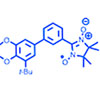| Mar 01, 2022 |
|
(Nanowerk News) Controlling the orientation of a single unpaired electron (called its spin) is no easy task, especially if the electron is in a molecule in its lowest energy state. Yet the ability to control the orientation of the electrons is important to the development of some quantum computing strategies.
|
|
In this research, scientists show that in a magnetic field, visible light can be used to influence a relative orientation of an unpaired electron in a molecule. When the molecule absorbs light, other electrons in the molecule are excited and become unpaired. The unpaired spins interact with each other, influencing how the electron spins recombine as the molecule relaxes. These interactions orient the remaining spin parallel or antiparallel to the direction of an applied magnetic field.
|
 |
| Visible light can control emissive or absorptive signals by influencing the relative populations of unpaired electron spin states (red dots on blue lines) in a population of molecules. (Image containing flipping man on grass courtesy of shutterstock.com. Overall image generated by D. Shultz)
|
|
To process information, some quantum computing strategies will rely on manipulation of the spin of electrons. However, it is challenging to control electrons’ spins.
|
|
This research identifies a strategy to influence the relative orientation of a spin that can be applied across a class of small molecules. This process “prepares” the spin for further manipulations required in the longer-term for technological applications.
|
|
This research takes a step toward these novel technologies by helping scientists control the properties of unpaired electrons through molecular design.
|
|
This study establishes a new strategy to control the orientation of an unpaired spin in a molecule in its lowest energy state (i.e., its ground state). An unusual feature of this approach is that the researchers believe it can be generalizable across a class of small molecules. These small molecules are designed to enter short-lived excited states that last less than a billionth of a second when they absorb light, even at very low temperatures of approximately 20 Kelvin.
|
|
The short lifetimes of these excited states, in concert with designed molecular features, determine the properties of the unpaired electron during the lifetime of the excited state and transmit those properties to the resulting “ground” state.
|
|
As a result, the approach can dramatically enhance the detectable features of the unpaired electron, and the sign of the signal can be reversed in less than a billionth of a second simply by exposing the molecules to visible light. Such a response holds promise for future quantum computing and quantum-based sensors, which may rely on spin control to advance quantum information science.
|
References
|
|
Kirk, M. L., et al., Metal Ion Control of Photoinduced Electron Spin Polarization in Electronic Ground States. Journal of the American Chemical Society 143, 10519–10523 (2021). [DOI: 10.1021/jacs.1c04149]
|
|
Kirk, M. L., et al., Chromophore-Radical Excited State Antiferromagnetic Exchange Controls the Sign of Photoinduced Ground State Spin Polarization. Chemical Science 12, 13704-13710 (2021). [DOI: 10.1039/D1SC02965G]
|


